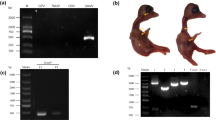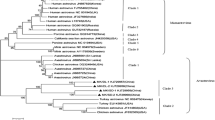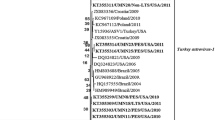Abstract
This study was conducted to determine genetic variations in the capsid gene of turkey astrovirus-2 (TAstV-2) detected in apparently healthy and poult enteritis syndrome (PES)-affected turkeys. Capsid genes of astroviruses obtained from 30 PES-affected and 45 apparently healthy turkey flocks had sequence homologies of 73.4-100% and 72.4-100% at the nucleotide levels, respectively. The analysis of deduced amino acid sequences revealed one amino acid deletion at position 552 in 28 (93.3%) of 30 PES-affected cases. However, there were two deletions (at positions 551 and 552) in 31 (68.9%) of 45 TAstV-2 from apparently healthy flocks. The TAstV-2 (6.7%) from two PES-affected cases had two amino acid insertions each between positions 552 and 553, while TAstV-2 from 14 (31.1%) of 45 healthy flocks had two insertions at the same position. Phylogenetic analysis based on nucleotide sequences revealed that the astroviruses in this study were closely related to most of the previously published TAstV-2 isolates. The sequence homology of TAstV-2 in this study ranged from 70.4% to 99.4% at the nucleotide level with those of previously published TAstV-2 isolates. The variations at the amino acid level in the capsid gene suggest the possibility of the existence of different serotypes of turkey astrovirus. The close relationship of turkey astroviruses from apparently healthy flocks to those from PES-affected cases in capsid gene phylogeny necessitates further studies to compare complete capsid gene sequences from both types of flocks from different geographic areas for better understanding of TAstV circulating in turkeys.


Similar content being viewed by others
References
Asplin FD (1965) Duck hepatitis. Vet Rec 77:487–488
Asplin FD (1965) Duck hepatitis: vaccination against two serological types. Vet Rec 77:1529–1530
Behling-Kelly E, Schultz-Cherry S, Koci MD, Kelley LA, Larsen DL, Brown C (2002) Localization of astrovirus in experimentally infected turkeys as determined by in situ hybridization. Vet Pathol 39:595–598
Cattoli G, De Battisti C, Toffan A, Salviato A, Lavazza A, Cerioli M, Capua I (2007) Co-circulation of distinct genetic lineages of astroviruses in turkeys and guinea fowl. Arch Virol 152:595–602
Gibson CA, Chen J, Monroe SA, Denison MR (1998) Expression and processing of nonstructural proteins of the human astroviruses. Adv Exp Med Biol 440:387–391
Gough RE, Collins MS, Borland E, Keymer LF (1984) Astrovirus-like particles associated with hepatitis in ducklings. Vet Rec 114:279
Gough RE, Borland ED, Keymer IF, Stuart JC (1985) An outbreak of duck hepatitis type II in commercial ducks. Avian Pathol 14:227–236
Hoshino Y, Zimmer JF, Moise NS, Scott FW (1981) Detection of astroviruses in feces of a cat with diarrhea. Arch Virol 70:373–376
Ishihama A, Barbier P (1994) Molecular anatomy of viral RNA-directed RNA polymerases. Arch Virol 134:235–258
Jiang B, Monroe SS, Koonin EV, Stine SE, Glass RI (1993) RNA sequence of astrovirus: distinctive genomic organization and a putative retrovirus-like ribosomal frame shifting signal that directs the viral replicase synthesis. Proc Natl Acad Sci USA 90:10539–10543
Jindal N, Patnayak DP, Chander Y, Ziegler AF, Goyal SM (2010) Detection and molecular characterization of enteric viruses from poult enteritis syndrome in turkeys. Poult Sci 89:217–226
Jindal N, Patnayak DP, Chander Y, Ziegler AF, Goyal SM (2010) Detection and molecular characterization of enteric viruses in breeder turkeys. Avian Pathol 39:53–61
Jindal N, Patnayak DP, Lago A, Ziegler AF, Goyal SM (2009) Experimental reproduction of poult enteritis syndrome: clinical findings, growth response, and microbiology. Poult Sci 88:949–958
Jindal N, Patnayak DP, Lago A, Ziegler AF, Goyal SM (2009) A retrospective study on poult enteritis syndrome in Minnesota. Avian Dis 53:268–275
Jonassen CM, Jonassen TØ, Sveen TM, Grinde B (2003) Complete genomic sequence of astroviruses from sheep and turkey: comparison with related viruses. Virus Res 91:195–201
Kjeldsberg E, Hem A (1985) Detection of astroviruses in gut contents of nude and normal mice. Arch Virol 84:135–140
Koci MD, Schultz-Cherry S (2002) Avian astroviruses. Avian Pathol 31:213–227
Koci MD, Seal BS, Schultz-Cherry S (2000) Molecular characterization of an avian astrovirus. J Virol 74:6173–6177
Koci MD, Seal BS, Schultz-Cherry S (2000) Development of an RT-PCR diagnostic test for an avian astrovirus. J Virol Methods 90:79–83
Madeley CR, Cosgrove BP (1975) 28 nm particles in faeces in infantile gastroenteritis (letter). Lancet 2:451–452
Matsui SM, Greenberg HB (2001) Astroviruses. In: Knipe DM, Howley PM (eds) Fields virology, vol 1, 4th edn. Lippincott Williams & Wilkins, Baltimore, pp 875–893
McNulty MS, Curran WL, McFerran JB (1980) Detection of astroviruses in turkey faeces by direct electron microscopy. Vet Rec 106:561
Pantin-Jackwood MJ, Day JM, Jackwood MW, Spackman E (2008) Enteric viruses detected by molecular methods in commercial chicken and turkey flocks in the United States between 2005 and 2006. Avian Dis 52:235–244
Pantin-Jackwood MJ, Spackman E, Day JM (2008) Pathogenesis of type 2 turkey astroviruses with variant capsid genes in 2-day-old specific pathogen free poults. Avian Pathol 37:193–201
Pantin-Jackwood MJ, Spackman E, Day JM, Rives D (2007) Periodic monitoring of commercial turkeys for enteric viruses indicates continuous presence of astrovirus and rotavirus on the farms. Avian Dis 51:674–680
Pantin-Jackwood MJ, Spackman E, Woolcock PR (2006) Molecular characterization and typing of chicken and turkey astroviruses circulating in the United States: implications for diagnostics. Avian Dis 50:397–404
Pantin-Jackwood MJ, Spackman E, Woolcock PR (2006) Phylogenetic analysis of turkey astroviruses reveals evidence of recombination. Virus Genes 32:187–192
Poch O, Sauvaget I, Delarue M, Tordo N (1989) Identification of four conserved motifs among the RNA-dependent polymerase encoding elements. EMBO J. 8:3867–3874
Reynolds DL, Saif YM (1986) Astrovirus: a cause of an enteric disease in turkey poults. Avian Dis 30:728–735
Reynolds DL, Saif YM, Theil KW (1987) A survey of enteric viruses of turkey poults. Avian Dis 31:89–98
Reynolds DL, Saif YM, Theil KW (1987) Enteric viral infections of turkey poults: incidence of infection. Avian Dis 31:272–276
Saif LJ, Saif YM, Theil KW (1985) Enteric viruses in diarrheic turkey poults. Avian Dis 29:798–811
Saif YM, Saif LJ, Hofacre CL, Hayhow C, Swayne DE, Dearth RN (1990) A small round virus associated with enteritis in turkey poults. Avian Dis 34:762–764
Schultz-Cherry S, King DJ, Koci MD (2001) Inactivation of an astrovirus associated with poult enteritis mortality syndrome. Avian Dis 45:76–82
Shimizu M, Shirai J, Narita M, Yamane T (1990) Cytopathic astrovirus isolated from porcine acute gastroenteritis in an established cell line derived from porcine embryonic kidney. J Clin Microbiol 28:201–206
Snodgrass DR, Gray EW (1977) Detection and transmission of 30 nm virus particles (astroviruses) in faeces of lambs with diarrhoea. Arch Virol 55:287–291
Strain E, Kelley LA, Schultz-Cherry S, Muse SV, Koci MD (2008) Genomic analysis of closely related astroviruses. J Virol 82:5099–5103
Tang Y, Saif YM (2004) Antigenicity of two turkey astrovirus isolates. Avian Dis 48:896–901
Tzipori S, Menzies JD, Gray EW (1981) Detection of astrovirus in the faeces of red deer. Vet Rec 108:286
Walter JE, Mitchell DK, Guerrero ML, Berke T, Matson DO, Monroe SS, Pickering LK, Ruiz-Palacios G (2001) Molecular epidemiology of human astrovirus diarrhea among children from a periurban community of Mexico city. J Infect Dis 183:681–686
Williams FP Jr (1980) Astrovirus-like, coronavirus-like and parvovirus-like particles detected in the diarrheal stools of beagle pups. Arch Virol 66:215–226
Woode GN, Bridger JC (1978) Isolation of small viruses resembling astroviruses and caliciviruses from acute enteritis of calves. J Med Microbiol 11:441–452
Yu M, Ismail MM, Qureshi MA, Dearth RN, Barnes HJ, Saif YM (2000) Viral agents associated with poult enteritis and mortality syndrome: the role of a small round virus and a turkey coronavirus. Avian Dis 44:297–304
Acknowledgments
This study was funded in part by a grant from the Rapid Agricultural Response Fund, University of Minnesota.
Conflict of interest
The authors declare that they have no conflict of interest.
Author information
Authors and Affiliations
Corresponding author
Rights and permissions
About this article
Cite this article
Jindal, N., Patnayak, D.P., Chander, Y. et al. Comparison of capsid gene sequences of turkey astrovirus-2 from poult-enteritis-syndrome-affected and apparently healthy turkeys. Arch Virol 156, 969–977 (2011). https://doi.org/10.1007/s00705-011-0931-1
Received:
Accepted:
Published:
Issue Date:
DOI: https://doi.org/10.1007/s00705-011-0931-1




